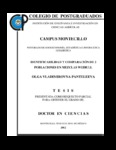| dc.contributor.author | Panteleeva, Olga Vladimirovna | |
| dc.creator | PANTELEEVA OLGA, VLADIMIROVNA; 168695 | |
| dc.date.accessioned | 2012-12-19T16:10:02Z | |
| dc.date.available | 2012-12-19T16:10:02Z | |
| dc.date.issued | 2012 | |
| dc.identifier.uri | http://hdl.handle.net/10521/1749 | |
| dc.description | Tesis (Doctorado en Ciencias, especialista en Estadística).- Colegio de Postgraduados, 2012. | en_US |
| dc.description.abstract | En este trabajo se investigan las mezclas finitas univariadas en particular en el caso de distribuciones Weibull. Para esto se revisa el problema de identificabilidad de los modelos de mezclas finitas Weibull, además son revisadas las propiedades de estos modelos: Distribución de probabilidad, valor esperado, varianza, función de momentos, función de confiabilidad y razón de fallas (hazard). Posteriormente se desarrollan las propiedades de los modelos de mezclas finitas con n componentes para variables aleatorias tipo Weibull con dos y tres parámetros. Se desarrollan las expresiones para calcular la moda y mediana de la función de densidad de los modelos de mezclas finitas con n componentes de distribución Weibull. Los resultados se llevan a cabo para mezclas con dos componentes, para la estimación de los parámetros se proporciona un bosquejo histórico de los diferentes métodos y algoritmos para la estimación de los parámetros de una mezcla finita, iniciando con el método de momentos hasta los métodos y algoritmos más actuales. Posteriormente los resultados obtenidos se aplican para determinar el ajuste de los tiempos de vida de 20 componentes electronicos, utilizando los criterios AIC y el valor de logverosimilitud para decidir sobre el mejor ajuste. En este problema se presenta una comparación de 4 algoritmos desarrollados en los últimos 5 años. Con los datos de este problema también se encuentran las funciones de confiabilidad y razón de fallas. El trabajo termina con el problema de comparación de mezclas Weibull. Se escribe el planteamiento del problema general de la comparación de dos poblaciones de mezclas Weibull con dos componentes. Se llevan a cabo dos pruebas paramétricas basadas en la razón de verosimilitud generalizada y dos pruebas no paramétricas, la prueba de Kolmogorov-Smirnov y la prueba de Anderson-Darling. _______________ IDENTIFIABILITY AND COMPARISON OF K-POPULATION ON WEIBULL MIXTURES. ABSTRACT: In this work finite mixtures univariate particularly in the case of Weibull distributions are investigated. For this the problem of identifiability of finite mixture Weibull models are reviewed, as well as the properties of these models also the following concepts are reviewed: Probability distribution, expected value, variance, moments function, reliability function and failure rate (hazard). Subsequently the properties of finite mixture models with n components Weibull type random variables with two and three parameters are developed. Then the properties of finite mixture models with n components such Weibull random variables with two and three parameters are developed. Expressions are developed to calculate the mode and median of the density function of finite mixture models with n Weibull distribution components . The results are carried out for two components mixtures, for estimating the parameters provide an historical sketch of the diferent methods and algorithms for estimating the parameters of a finite mixture, starting with the method of moments to the current methods and algorithms. Then the results are applied to determine the fit of 20 lifetimes of electronic components, using the Akaike 's information criterion and the value of log-likelihood to decide what estimators do the best fit. In this issue we present a comparison of 4 algorithms developed over the past 5 years. With the data of this problem also functions of reliability and fault reason are. The work ends with the problem of comparison of Weibull mixtures. We write the approach of the general problem of comparing two populations of Weibull mixtures with two components. Carried out two parametric tests based on generalized likelihood ratio and two nonparametric tests, the Kolmogorov-Smirnov test and the Anderson-Darling test. | en_US |
| dc.description.sponsorship | Consejo Nacional de Ciencia y Tecnología (CONACYT). | en_US |
| dc.language.iso | spa | en_US |
| dc.rights.uri | http://creativecommons.org/licenses/by-nc-nd/4.0 | |
| dc.subject | Confiabilidad y función de taza de falla | en_US |
| dc.subject | Identificabilidad | en_US |
| dc.subject | Algoritmo EM | en_US |
| dc.subject | Error medio cuadrado | en_US |
| dc.subject | Prueba de Kolmogorov-Smirnov | en_US |
| dc.subject | Prueba de Anderson-Darling | en_US |
| dc.subject | Reliability and failure rate functions | en_US |
| dc.subject | Identifiability | en_US |
| dc.subject | EM algorithm | en_US |
| dc.subject | Mean square error | en_US |
| dc.subject | Kolmogorov-Smirnov test | en_US |
| dc.subject | Anderson-Darling test | en_US |
| dc.subject | Estadísica | en_US |
| dc.subject | Doctorado | en_US |
| dc.title | Identificabilidad y comparación de k-poblaciones en mezclas weibull | en_US |
| dc.type | Tesis | en_US |
| Tesis.contributor.advisor | Vaquera Huerta, Humberto | |
| Tesis.contributor.advisor | Villaseñor Alva, José A. | |
| Tesis.contributor.advisor | González Estrada, Elizabeth | |
| Tesis.contributor.advisor | García Cue, José Luis | |
| Tesis.contributor.advisor | Crossa Hiriart, José Luis | |
| Tesis.date.submitted | 2012 | |
| Tesis.date.accesioned | 2012-11-11 | |
| Tesis.date.available | 2012-12-19 | |
| Tesis.format.mimetype | pdf | en_US |
| Tesis.format.extent | 1,115 KB | en_US |
| Tesis.subject.nal | Estadístico de Weibull | en_US |
| Tesis.subject.nal | Weibull statistics | en_US |
| Tesis.subject.nal | Algoritmos | en_US |
| Tesis.subject.nal | Algorithms | en_US |
| Tesis.rights | Acceso abierto | en_US |
| Articulos.subject.classification | Estadística | en_US |
| dc.type.conacyt | doctoralThesis | |
| dc.identificator | 5 | |
| dc.contributor.director | VAQUERA HUERTA, HUMBERTO; 120229 | |


